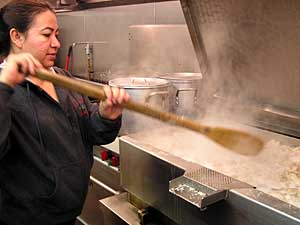|
Photos
|
June 13, 2005
 |
| Noelia Garcia stirs a tank of boiling chicken. Garcia and her husband own La Loma, a commercial kitchen in Minneapolis that makes about 13,000 tamales a week. (MPR Photo/Bianca Vazquez Toness ) |
Minneapolis, Minn. — If you've eaten a restaurant tamale in the Twin Cities, it may have come from La Loma, a tamale kitchen in South Minneapolis.
The owners, Enrique, 29, and Noelia Garcia, 30, make almost a dozen different kinds of tamales. There are chicken tamales with different sauces -- red salsa, mole and green salsa. There are sweet tamales with corn, pineapple or raisins. They've even catered to vegetarian eaters with bean and cheese or vegetables.
Whatever the filling, making tamales is arduous, even when you've got electricity and fancy equipment. Turning fresh corn into dough or masa takes the most time.
Standing next to a large steel tank, Enrique Garcia explains the first step to process the corn. "We get a product called lime," he explains. "In Spanish it's cal. So, we can cook the corn. And the corn get's pure."
Workers here boil big batches of corn, about 200 pounds at a time, with lime to remove its hard shell.
Then they dry the corn in a refrigerator for about 24 hours. Once it's dry, they grind it by machine into flour. They use another machine to mix the flour with lard, and a sauce made from red chiles.
The process from start to finish is long, and that doesn't include making the filling. Even so, the Garcias make about 13,000 tamales a week. Soon they plan to make that many each day to sell to grocery stores.
How's that possible? We'll get to that.
Enrique and Noelia are modest about their success. They say it took a lot of hard work, especially because of how little they started with.
They got married when they were 17 and 18. Two days later they left their small town in Mexico for the states.
"We got the idea that we are gonna come one two years and we're gonna be rich," Enrique says laughing. "But, it's not that way."
Enrique worked as a cook for years, doing stints at Italian, Tex-Mex and French restaurants.
"But I never cooked Mexican food," he says. "When I get to Minnesota I hardly knew how to cook anything. Nothing. In Mexico, the men don't cook. We're to work and that's it. You don't get into the kitchen."
One day, about six years ago, Enrique and Noelia made tamales at home and took them for lunch. Their coworkers liked them so much they wanted to buy them. So, the Garcias rented a small table and two burners in a commercial kitchen and eventually took over the entire kitchen. Soon they were making a lot of tamales.
"But we never knew that we need a license to do that," Enrique says. "So we get in trouble after two years because we're doing wholesale without a license."
The Garcias took the required classes and finally got their license.
That wasn't the only homework they had to do. Noelia spent months researching and refining each recipe they use. But there was one recipe that came easier than the others. That's because it was her mother's. Noelia's mom had a tamale business, and as a girl, Noelia sold them around town.
Noelia's mother put the tamales in a "little basket or bucket with a napkin on top." Noelia sold the tamales door-to-door.
Once the workers have prepared the chicken and the masa or dough, they're ready to put together the tamales. This is one of the last steps they still do by hand.
It's assembly-line style and about half a dozen people stand around a long table. One person pulls out a banana leaf, the next puts on the masa or dough. Then the chicken fried in red chile sauce goes on top and the last person wraps it up. But all that may change.
The Garcias want to make five times as many tamales as they do now and a new machine may help with that assembly. But it's not a sure thing yet. They'll only buy the new equipment if it doesn't change the quality of their tamales.
They want their tamales to taste the same next year as they did six years ago when they made the tamales with their own hands in a tiny rented kitchen.






